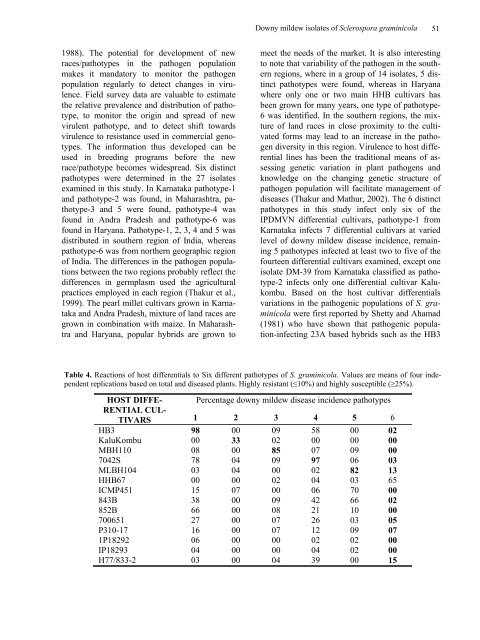Characterization of downy mildew isolates of Sclerospora ...
Characterization of downy mildew isolates of Sclerospora ...
Characterization of downy mildew isolates of Sclerospora ...
You also want an ePaper? Increase the reach of your titles
YUMPU automatically turns print PDFs into web optimized ePapers that Google loves.
1988). The potential for development <strong>of</strong> new<br />
races/pathotypes in the pathogen population<br />
makes it mandatory to monitor the pathogen<br />
population regularly to detect changes in virulence.<br />
Field survey data are valuable to estimate<br />
the relative prevalence and distribution <strong>of</strong> pathotype,<br />
to monitor the origin and spread <strong>of</strong> new<br />
virulent pathotype, and to detect shift towards<br />
virulence to resistance used in commercial genotypes.<br />
The information thus developed can be<br />
used in breeding programs before the new<br />
race/pathotype becomes widespread. Six distinct<br />
pathotypes were determined in the 27 <strong>isolates</strong><br />
examined in this study. In Karnataka pathotype-1<br />
and pathotype-2 was found, in Maharashtra, pathotype-3<br />
and 5 were found, pathotype-4 was<br />
found in Andra Pradesh and pathotype-6 was<br />
found in Haryana. Pathotype-1, 2, 3, 4 and 5 was<br />
distributed in southern region <strong>of</strong> India, whereas<br />
pathotype-6 was from northern geographic region<br />
<strong>of</strong> India. The differences in the pathogen populations<br />
between the two regions probably reflect the<br />
differences in germplasm used the agricultural<br />
practices employed in each region (Thakur et al.,<br />
1999). The pearl millet cultivars grown in Karnataka<br />
and Andra Pradesh, mixture <strong>of</strong> land races are<br />
grown in combination with maize. In Maharashtra<br />
and Haryana, popular hybrids are grown to<br />
Downy <strong>mildew</strong> <strong>isolates</strong> <strong>of</strong> <strong>Sclerospora</strong> graminicola 51<br />
A<br />
Table 4. Reactions <strong>of</strong> host differentials to Six different pathotypes <strong>of</strong> S. graminicola. Values are means <strong>of</strong> four independent<br />
replications based on total and diseased plants. Highly resistant (≤10%) and highly susceptible (≥25%).<br />
HOST DIFFE-<br />
RENTIAL CUL-<br />
TIVARS<br />
meet the needs <strong>of</strong> the market. It is also interesting<br />
to note that variability <strong>of</strong> the pathogen in the southern<br />
regions, where in a group <strong>of</strong> 14 <strong>isolates</strong>, 5 distinct<br />
pathotypes were found, whereas in Haryana<br />
where only one or two main HHB cultivars has<br />
been grown for many years, one type <strong>of</strong> pathotype-<br />
6 was identified. In the southern regions, the mixture<br />
<strong>of</strong> land races in close proximity to the cultivated<br />
forms may lead to an increase in the pathogen<br />
diversity in this region. Virulence to host differential<br />
lines has been the traditional means <strong>of</strong> assessing<br />
genetic variation in plant pathogens and<br />
knowledge on the changing genetic structure <strong>of</strong><br />
pathogen population will facilitate management <strong>of</strong><br />
diseases (Thakur and Mathur, 2002). The 6 distinct<br />
pathotypes in this study infect only six <strong>of</strong> the<br />
IPDMVN differential cultivars, pathotype-1 from<br />
Karnataka infects 7 differential cultivars at varied<br />
level <strong>of</strong> <strong>downy</strong> <strong>mildew</strong> disease incidence, remaining<br />
5 pathotypes infected at least two to five <strong>of</strong> the<br />
fourteen differential cultivars examined, except one<br />
isolate DM-39 from Karnataka classified as pathotype-2<br />
infects only one differential cultivar Kalukombu.<br />
Based on the host cultivar differentials<br />
variations in the pathogenic populations <strong>of</strong> S. graminicola<br />
were first reported by Shetty and Ahamad<br />
(1981) who have shown that pathogenic population-infecting<br />
23A based hybrids such as the HB3<br />
Percentage <strong>downy</strong> <strong>mildew</strong> disease incidence pathotypes<br />
1 2 3 4 5 6<br />
HB3 98 00 09 58 00 02<br />
KaluKombu 00 33 02 00 00 00<br />
MBH110 08 00 85 07 09 00<br />
7042S 78 04 09 97 06 03<br />
MLBH104 03 04 00 02 82 13<br />
HHB67 00 00 02 04 03 65<br />
ICMP451 15 07 00 06 70 00<br />
843B 38 00 09 42 66 02<br />
852B 66 00 08 21 10 00<br />
700651 27 00 07 26 03 05<br />
P310-17 16 00 07 12 09 07<br />
1P18292 06 00 00 02 02 00<br />
IP18293 04 00 00 04 02 00<br />
H77/833-2 03 00 04 39 00 15
















